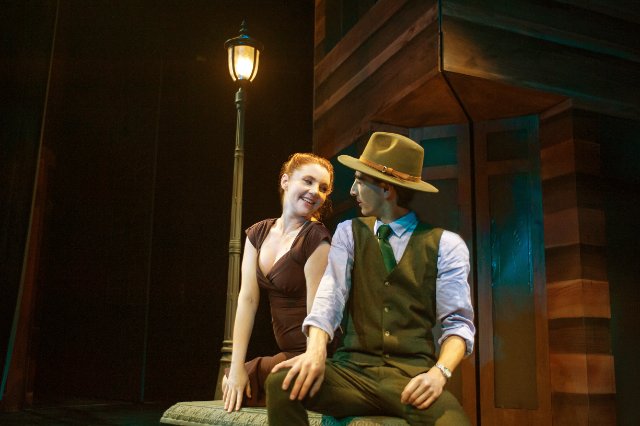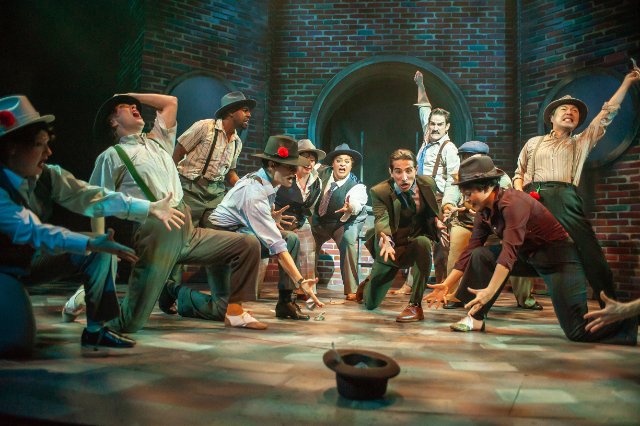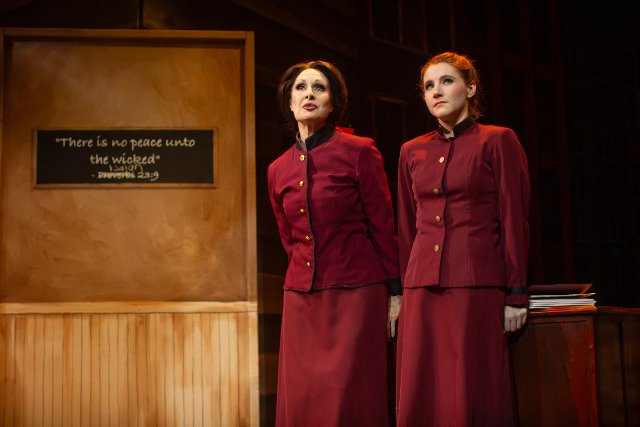Guys and Dolls
World of Damon Runyon, Music and Lyrics of Frank Loesser
By: Victor Cordell - Nov 25, 2023
The award winning 1950 Broadway musical “Guys and Dolls” succeeded in its debut run and in several revivals. But for many, the 1955 film starring Marlon Brando and Frank Sinatra, represents their only knowledge of the piece. As an aside, Sinatra played tin-eared Nathan Detroit. The character was given only one song in the stage version, as the role was written for Sam Levene, and he lacked singing chops. Meanwhile, Brando had the Sky Masterson role with the great singing!?!?
While the film succeeded in many ways, some viewers today could see “Guys and Dolls” as antiquated and the casting and acting stilted to distraction – hardly likely to encourage viewers to go to a stage version. That might be a mistake. Driven by strong production values and four talented leads, San Francisco Playhouse’s rendition offers a nostalgic time and place capsule, albeit not without flaws.
Author Damon Runyan cut a unique swath through the American persona, uncovering colorful characters and situations around Depression Era Broadway. His world was one of people living on the edge – the demimonde of performers, gamblers, gangsters, tricksters, and women who turn tricks. His stories form the basis for “Guys and Dolls,” one of over a dozen plays and movies to draw on his fiction.
One conversation that theater goers often have is whether they care about the characters or can relate to them. Most would not relate to the motley crew in “Guys and Dolls,” but many would empathize with them. They might feel for Nathan Detroit, but probably wouldn’t want him as a brother-in-law. Played adeptly as grizzled and stressed by Joel Roster, he earns a hand-to-mouth existence as the proprietor of floating craps games. Nathan does have a love life as well – a 14-year engagement to Adelaide, a nightclub singer.
Melissa WolfKlain delights as Adelaide, the most challenging of the roles, having to maintain a mousy Brooklyn accent not only for her comedic contributions, but also for her considerable singing requirements to be on key and off kilter at the same time. Perhaps the best example of that is when she nails the popular “Adelaide’s Lament” in which she attributes all of her maladies to not being able to get Nathan to the altar, e.g., ‘Just from wondering whether the wedding is on or off. One could develop a cough.’ Meanwhile, she has been sending letters to her mother for years saying not only that she’s been married, but that they now have five children!
If Adelaide and Nathan’s endless engagement is the classic conflict between the party who wants to make a commitment and the other who won’t, the second couple is the classic case of opposites attracting. The suave and cool Sky Masterson (played suavely and cooly by David Toshiro Crane), occasionally participates in Nathan’s games, and he will bet on anything. As an indication of how silly the script can be, Nathan needs $1,000 to pay for a venue for his next craps game, and he bets Sky that he won’t be able to get a particular young woman to go to dinner with him in Havana. (If you can remember a time when you could fly on a whim to Cuba from the U.S., you’re old.)
So what’s the catch? Nathan figures he has a sure bet, as his pick, the prim and proper Sergeant Sarah Brown, portrayed as physically and morally upright by Abigail Esfira Campbell, is a uniformed member of the Times Square Save-A-Soul Mission. Her mission should be clear, and she’s clearly not accomplishing it. You guessed right presuming that you predicted Sky would succeed in spiriting Sarah to Cuba, and Sky even gets her to loosen up a bit with the help of some of the island’s finest, highly disguised libations. The couple’s new found feelings and beautiful voices are on display in the Act 1 finale, “I’ve Never Been in Love Before,” a wonderful duet with a life outside the musical. Needless to say, plenty of action follows in Act 2.
The Frank Loesser score of “Guys and Dolls” contains many pleasant numbers, though some of them are somewhat glued to the storyline such as “Luck Be a Lady” and “Tinhorns’ Fugue.” If the latter title is unfamiliar, it’s the bouncy gamblers’ song with the lyrics ‘Can do. Can do. This guy says the horse can do.’ It is a brief but exceptional three-part counterpoint that is delivered exceptionally well and picks up the pace near the start after an overture that is uninspired in terms of its music, its playing, and its choreography. Nicole Helfer’s choreography is otherwise strong throughout. Execution varies but is best when danced by characters who in the script are supposed to be dancers, and at the other extreme, when non-dance movement is individualistic.
A final highlight is the staging, which as usual, takes advantage of the facility’s revolving stage, which is the investment that keeps on giving. Designer Heather Kenyon’s angular street scape of three-story buildings in subtle but varied colors, reminiscent of an Edward Hopper painting, gives way to a nightclub, a parking garage, the mission office and more. Along with other creative contributions, Director Bill English keeps the action moving and ties all the strings together.
“Guys and Dolls,” with music and lyrics by Frank Loesser and book by Abe Burrows & Jo Swerling based on short stories by Damon Runyon, is produced by San Francisco Playhouse and appears on its stage at 450 Post Street, San Francisco, CA through January 13, 2024.






